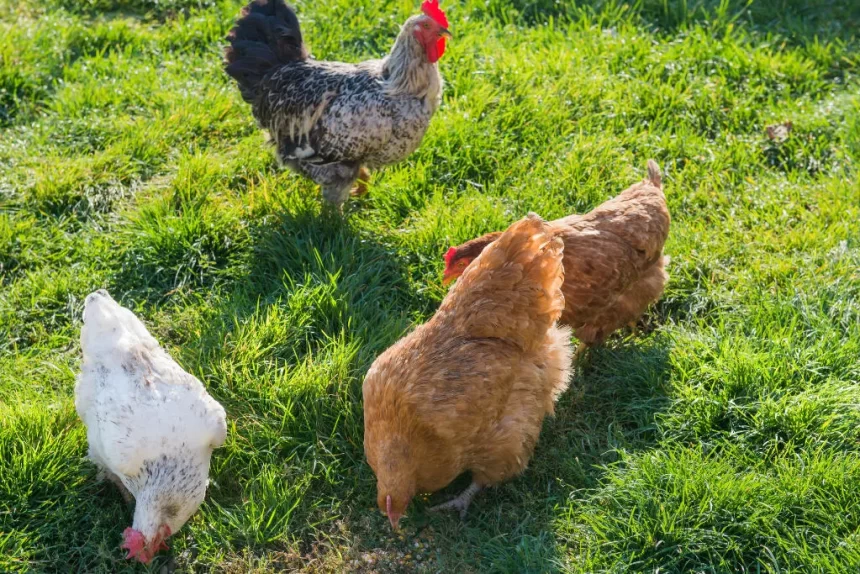Celery is a common vegetable that most people have in their refrigerators. With it’s crunchy texture and fresh, slightly bitter taste, it’s a popular choice for eating raw or cooking. But what about feeding celery to chickens? Can chickens eat celery?
As backyard chicken keepers know, chickens will eat just about anything. They forage and peck at the ground, exploring new foods. However, just because chickens will eat something doesn’t mean it’s good for them. Some human foods can be unhealthy or even toxic, for chickens. So it’s important to educate yourself before tossing table scraps into the coop.
This article will look at if chickens can safely and healthily eat celery. It will cover the nutrients in celery, the good and bad points of feeding it, and how much to give chickens. It will also explain the best way to feed celery to chickens. After reading, you’ll know if you can share this crunchy, green vegetable with your chickens and how to do it properly.
Nutritional Value of Celery for Chickens
What does celery offer chickens nutritionally? Here’s a breakdown:
Water Content
Celery is 95% water, making it a very hydrating choice. Dehydration is a serious health issue for chickens, so providing water-rich foods is important. The high water content also means celery can help chickens feel full without consuming a lot of calories.
Fiber
Celery contains insoluble fiber, mostly in it’s stringy parts. Fiber promotes healthy digestion and nutrient absorption in a chicken’s digestive tract. It may also help with cholesterol levels.
Vitamins and Minerals
While not the most nutrient-dense vegetable, celery does contain some important vitamins and minerals. This includes vitamin K, potassium, vitamin C, vitamin B6, folate and more. The nutrients support bone, muscle, blood, immune system and other health.
So in terms of nutritional value for chickens, celery does have some perks. The main benefits come from it’s hydrating quality and fiber content.
Pros of Feeding Celery to Chickens
There are a few advantages to adding celery to a chicken’s diet. Here are some of the main pros:
- Hydration: As mentioned, celery is very hydrating. Feeding it can prevent dehydration in hot weather or when chickens are ill. Dehydration causes serious health issues in chickens, so celery is beneficial.
- High Fiber: The insoluble fiber in celery promotes good digestion and gut health. Healthy digestion means better absorption of nutrients from other foods.
- Low Calorie: Celery is very low in calories and fat. This makes it a great diet food for overweight or obese chickens. It provides nutrients and hydration without excess calories that lead to weight gain.
- Provides Variety: Adding different treats and table scraps creates more variety in a chicken diet. Variety staves off boredom and ensures chickens receive diverse nutrients from different foods.
- Easy to Digest: Since it’s mostly water and fiber, celery is easy for chickens to break down and digest. This makes it a good option for young chicks or chickens with digestive issues.
These are the main advantages of mixing some celery into a chicken’s feeding routine. Of course, there are also some potential downsides to consider before offering it.
Cons of Feeding Celery to Chickens
While celery has nutritional value for chickens, there are some cons to feeding large amounts:
- Not Very Nutrient-Dense: Celery contains decent vitamins and minerals. However, it’s nutrient levels are lower than leafy greens, vegetables, berries and chicken feed. So relying too heavily on celery could lead to deficiencies over time.
- Causes Watery Droppings: Due to it’s high water content, celery can give chickens loose, watery droppings if they eat a lot of it. This is unhealthy and promotes parasitic growth. Monitor droppings when feeding celery.
- Risk of Choking: Celery is stringy and crunchy. Chickens that gulp down pieces too fast or whole could potentially choke. Cut celery into small pieces before feeding to prevent this.
- Can Contain Pesticides: Conventionally-grown celery is prone to high pesticide residue. Organic is best. Wash all celery thoroughly before giving it to chickens to limit chemical consumption.
These cons don’t necessarily mean chickens can’t or shouldn’t eat any celery. But it highlights the importance of only feeding it in moderation. Now let’s look at exactly how much celery chickens can eat.
How Much Celery Can Chickens Eat?
When giving chickens new foods, it’s always wise to start slow. Begin by only feeding a small amount of celery at first. Observe how your chickens react. Make sure it does not significantly change their droppings or cause any choking.
If all goes well, build up from there. About 1-2 inches of chopped celery per chicken is an appropriate daily amount. Feed higher quantities every 2-3 days rather than daily servings. This prevents too much water consumption at once.
Free-range chickens that graze on grass, bugs and other foods likely only need celery as a supplemental treat. But chickens confined to a run may be able to eat slightly larger quantities more frequently. Just watch their manure and weight.
Adjust as needed if you notice changes after feeding celery. Every flock is different, so pay attention and find what works best through observation.
Some additional tips on amounts:
- Very young chicks should not eat celery due to choking risk. Wait until fully feathered.
- Overweight chickens can eat celery daily since it’s low-calorie. Increase amounts gradually.
- Egg-laying hens benefit from daily celery for hydration and nutrient boosts. But monitor egg quality.
- Broody hens may enjoy crunchy celery since they aren’t moving around much while sitting.
Now that I’ve covered if and how much celery chickens can eat, let’s talk about the best ways to feed it.
How to Feed Celery to Chickens
Preparing the celery properly before serving makes it safer and easier for chickens to eat. Here are some tips:
- Chop It Up: Always chop celery stalks and leaves into small, bite-sized pieces before feeding. Around 1⁄4 to 1⁄2 inch pieces is best. This prevents choking.
- Remove Strings: The fibrous strings in celery can be tricky for chickens. Pull them out before chopping it into pieces for the flock. Check for tiny strings left behind too.
- Cut Off Leaves: Celery leaves contain more nutrients than the stalks. Chop and feed leaves to give an extra nutrition boost.
- Wash Thoroughly: Scrub all surfaces under cool water before chopping. This removes dirt, debris and any pesticide residue. Pat dry with towels.
- Mix With Other Veggies: For diversity of nutrients, consider mixing chopped celery in with other vegetable scraps like carrots, squash, greens and sprouts.
- Feed Near Water Source: Since it’s very hydrating, feeding celery near chickens’ fresh water source lets them replenish as needed.
Follow these simple tips for preparing and serving celery safely. Change amounts given based on observation of your unique flock after eating it.
Health Risks of Feeding Celery to Chickens
When fed properly and in moderation, celery poses very little risk to chicken health. The biggest dangers come from contamination or feeding mistakes, including:
- Pesticide Poisoning: Conventional celery is heavily sprayed with pesticides that can transfer through the skin. Only buy organic celery or wash extremely thoroughly before feeding.
- Choking Hazard: Celery pieces that are too large or stringy can get caught in a chicken’s throat. Always chop into small bites and remove strings to prevent choking deaths.
- Intestinal Blockages: Extremely fibrous celery leaves could potentially cause intestinal blockages if a large quantity is eaten. Chop leaves finely to minimize this danger.
- Dehydration: While celery is hydrating, relying too heavily on watery vegetables instead of drinking water directly can backfire. Ensure adequate water supply alongside any vegetable hydration sources.
As long as celery is washed, chopped and fed properly, it poses little real health risk and can be a nutritious, low-calorie treat.
Signs of Excess Consumption
Chickens fed reasonable celery amounts typically tolerate it well. But eating too much could cause issues like:
- Digestive Problems: Excess celery may irritate the digestive tract, causing diarrhea or constipation. Scale back feeding if these issues emerge after serving celery.
- Watery Droppings: The high water content of celery can lead to very loose, wet droppings if too much is consumed. This needs to be remedied or parasites may grow.
- Odd Eggs: In egg-laying hens, excess celery could impact egg quality, size and shell thickness. Decrease amounts if odd eggs emerge.
- Weight Gain/Loss: Too much celery may suppress appetite, causing weight loss over time. But chickens that gorge could gain excess weight if combining it with high amounts of feed or other foods.
Adjust celery quantities based on these types of reactions in individual chickens. Most issues resolve by scaling back volume.
What Parts Of The Celery Plant Can Chickens Eat?
Chickens can safely eat all parts of the celery plant, including:
Celery Stalks
- The crunchy stalks provide hydration, fiber and some vitamins and minerals. Make sure to chop the stalks into small, chicken-sized bites first.
Leaves
- Celery leaves actually contain more nutrients than the stalks, packing higher amounts of vitamin K, vitamin A, lutein and folate. The leaves do have more fiber though, so chop them very finely before feeding.
Flowers
- Yes, chickens can eat celery flowers too! They provide nectar, pollen and pigments. Just offer them as a treat, not a main food source.
Seeds
- Mature celery plants produce small tan/brown seeds that chickens enjoy eating. The seeds are very nutritious additions, full of healthy oils and protein.
Root Base
- Don’t throw away those old celery bases! Chop up the root end along with any attached leaves to give chickens an edible, nutritional toy filled with fiber and minerals.
Can Chickens Eat Celery Leaves?
Celery leaves offer more nutrients than the stalks alone. So can chickens eat celery leaves too? The answer is yes!
Chicken keepers often toss old celery bases with leaves still attached into the coop as an edible toy. Chickens will pick at and ingest the leaves first since it’s the tastiest, most nutrient-dense part. They get the best “bang for their buck” by going for the leaves.
The only caution with celery leaves is to chop them finely due to the fibrous nature. Whole leaves present a choking risk. But chopped into bite-size bits, both the stems and leaves make a healthy, hydrating snack for chickens.
Celery Leaves vs. Stalk Nutrition
So in what ways are celery leaves more nutritious for chickens than stalks? Here’s a nutritional comparison:
| Vitamin K | Essential for blood health and bone density, celery leaves contain over 6 times more vitamin K than stalks. |
| Vitamin A | Vital for eye and skin health, celery leaves provide nearly 3 times the vitamin A as stalks pound for pound. |
| Lutein | This antioxidant boosts immunity and eye function. Leaves contain significantly higher lutein levels than stalks. |
| Folate | Necessary for metabolism and red blood cell production, leaves offer much more folate than stalks. |
As you can see, celery leaves beat out stalks in several key nutrients chickens need. Next time you buy celery, lop off the base with leaves and chop the entire thing to feed your flock.
FAQs
No, baby chicks under 4 weeks old should not eat celery or any vegetables. Their digestive systems can’t handle it. Wait until fully feathered at 8 weeks for celery.
Most chickens do enjoy celery! Particularly the crunchy texture. The enjoyment level depends somewhat on breed and individual taste. But the majority will eat both the stalks and leaves.
No, celery is not a significant source of calcium, providing just 2% per cup. To boost eggshell calcium, feed things like oyster shell, bone meal, dairy products and dark leafy greens instead.
Yes, you can overdo it on the celery. Too much can lead to loose droppings, intestinal issues and poor nutrition from replacing other foods. Feed just 1-2 inches of chopped celery tops per chicken at a time.
It’s best to avoid feeding chickens rotting celery with mold or slime. The deterioration allows pathogens and toxins to grow which can make chickens sick. Stick to fresh, crunchy celery only.
Conclusion
Celery is an OK addition to a backyard chicken diet. In moderation, it provides hydration, fiber, low calories and some vitamins and minerals. Follow proper preparation methods and watch for signs of excess consumption. While not the most nutrient-dense vegetable, the high water content and crunch make it a suitable supplemental snack.
So based on the nutritional profile, pros vs. cons analysis and proper feeding tips covered here, yes – chickens can eat celery! Both the stalks and leaves provide benefits. Celery gives backyard chickens some extra diet variety. Try offering small amounts and see if your flock enjoys this crispy, hydrating treat.




